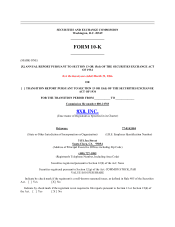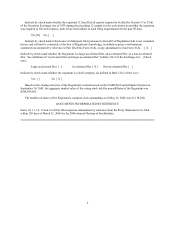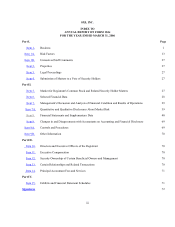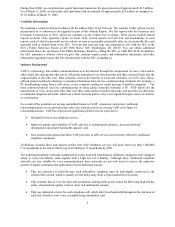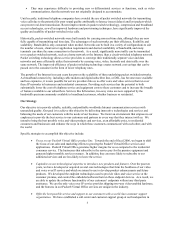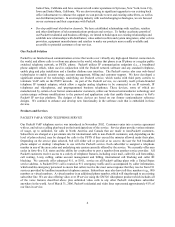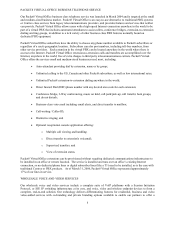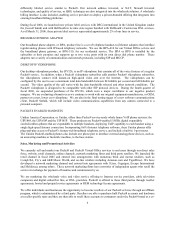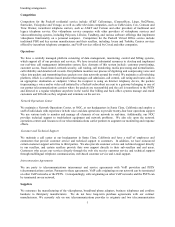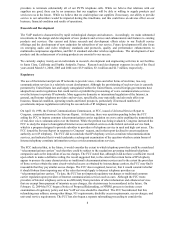8x8 2006 Annual Report Download - page 11
Download and view the complete annual report
Please find page 11 of the 2006 8x8 annual report below. You can navigate through the pages in the report by either clicking on the pages listed below, or by using the keyword search tool below to find specific information within the annual report.8
providers to terminate substantially all of our PSTN telephone calls. While we believe that relations with our
suppliers are good, there can be no assurance that our suppliers will be able or willing to supply products and
services to us in the future. While we believe that we could replace our suppliers if necessary, our ability to provide
service to our subscribers would be impacted during this timeframe, and this could have an adverse effect on our
business, financial condition and results of operations.
Research and Development
The VoIP market is characterized by rapid technological changes and advances. Accordingly, we make substantial
investments in the design and development of new products and services and enhancements and features to existing
products and services. Our current and future research and development efforts relate to our Packet8 service
offerings and the development of new endpoints for subscribers of our service. Future development will also focus
on emerging audio and video telephony standards and protocols, quality and performance enhancements to
multimedia compression algorithms, and 802.11 standard and other wireless applications. The development of new
products and the enhancement of existing products are essential to our success.
We currently employ twenty-seven individuals in research, development and engineering activities in our facilities
in Santa Clara, California and Sophia Antipolis, France. Research and development expenses in each of the fiscal
years ended March 31, 2006, 2005 and 2004 were $5.9 million, $3.1 million and $2.7 million, respectively.
Regulatory
The use of the Internet and private IP networks to provide voice, video and other forms of real-time, two-way
communications services is a relatively recent development. Although the provisioning of such services is currently
permitted by United States law and largely unregulated within the United States, several foreign governments have
adopted laws and/or regulations that could restrict or prohibit the provisioning of voice communications services
over the Internet or private IP networks. More aggressive domestic or international regulation of the Internet, in
general, and Internet telephony providers and services, specifically, may materially and adversely affect our
business, financial condition, operating results and future prospects, particularly if increased numbers of
governments impose regulations restricting the use and sale of IP telephony services.
On April 10, 1998, the Federal Communications Commission, or FCC, issued a Universal Service Report to
Congress, commonly known as the Stevens Report. At that time, there was a petition pending before the FCC
asking the FCC to impose common telecommunications carrier regulation on every entity enabling the transmission
of real-time voice communication over the Internet. While the petition was being evaluated, Congress instructed the
FCC to study the impact of unregulated Internet access and related services on the federal universal service fund,
which is a program designed to provide subsidies to providers of telephone service in rural and high cost areas. The
FCC issued the Stevens Report in response to Congress’ request, and in that report declined to assert regulatory
authority over IP telephony. The FCC did not conclude that IP telephony services constitute telecommunications
services, and indicated that it would undertake a subsequent examination of the question whether certain forms of
Internet telephony constitute information services or telecommunications services.
The FCC indicated that, in the future, it would consider the extent to which telephony providers could be considered
“telecommunications carriers” such that they could be subject to the regulations governing traditional telephone
companies such as the imposition of access charges. The FCC stated that, although it did not have a sufficient record
upon which to make a definitive ruling, the record suggested that, to the extent that certain forms of IP telephony
appear to possess the same characteristics as traditional telecommunications services and to the extent the providers
of those services obtain the same circuit-switched access as obtained by interexchange carriers, the FCC may find it
reasonable that they pay similar access charges. The FCC also recognized, however, that it would consider whether
it should forbear from imposing any of the rules that would apply to Internet telephony providers as
“telecommunications carriers.” To date, the FCC has not imposed regulatory surcharges or traditional common
carrier regulation upon providers of Internet communications services such as ours. Although the FCC treats
providers of Internet telephony services no differently from providers of other information and enhanced services
that are exempt from payment of interstate access charges, this decision may be reconsidered in the future. On
February 12, 2004 the FCC began a Notice of Proposed Rulemaking, or NPRM, process to institute a new
examination of regulatory policy and how VoIP services should be classified. The FCC has indicated that this
rulemaking may address, among other things, 911 requirements, disability access requirements, access charges, and
universal service requirements. The FCC has also begun a separate rulemaking proceeding to consider the

